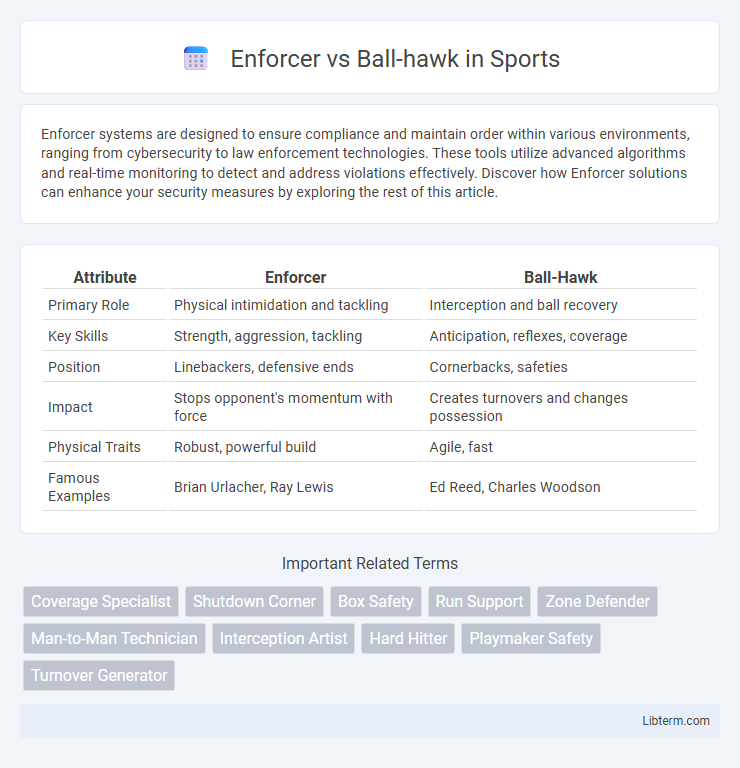Enforcer systems are designed to ensure compliance and maintain order within various environments, ranging from cybersecurity to law enforcement technologies. These tools utilize advanced algorithms and real-time monitoring to detect and address violations effectively. Discover how Enforcer solutions can enhance your security measures by exploring the rest of this article.
Table of Comparison
| Attribute | Enforcer | Ball-Hawk |
|---|---|---|
| Primary Role | Physical intimidation and tackling | Interception and ball recovery |
| Key Skills | Strength, aggression, tackling | Anticipation, reflexes, coverage |
| Position | Linebackers, defensive ends | Cornerbacks, safeties |
| Impact | Stops opponent's momentum with force | Creates turnovers and changes possession |
| Physical Traits | Robust, powerful build | Agile, fast |
| Famous Examples | Brian Urlacher, Ray Lewis | Ed Reed, Charles Woodson |
Definition: Enforcer vs Ball-Hawk
An enforcer in football is a defensive player known for their physicality, aggressiveness, and ability to intimidate opponents through hard tackles and strong hits. A ball-hawk, on the other hand, specializes in pass defense, displaying exceptional skills in intercepting passes, reading the quarterback's intentions, and creating turnovers. While enforcers focus on impact and physical dominance, ball-hawks prioritize anticipation, coverage, and playmaking in the defensive backfield.
Key Traits of an Enforcer
An Enforcer in football is characterized by physicality, aggression, and the ability to control the line of scrimmage through powerful tackles and blocks. Key traits include dominance in run defense, relentless pursuit of ball carriers, and intimidation that disrupts offensive rhythm. This role demands exceptional strength, tackling technique, and a mindset focused on imposing physical presence to halt opposing offenses.
Core Skills of a Ball-Hawk
A Ball-hawk excels in anticipatory skills, reading the quarterback's eyes, and maintaining exceptional speed and agility to close gaps quickly. Their core abilities include precise interception timing, strong hands for ball control, and sharp instincts to predict routes and disrupt passes. Unlike enforcers who rely on physicality, ball-hawks prioritize coverage skills and ball awareness to turn defense into scoring opportunities.
Roles in Defensive Strategy
The enforcer role in defensive strategy emphasizes physicality and intimidation, aiming to disrupt opponents through strong tackles and enforcing team toughness. Ball-hawks prioritize ball skills and anticipation, excelling at intercepting passes and creating turnovers by reading the quarterback's intentions. Both roles are crucial in a defensive unit, where enforcers deter opponents' aggression and ball-hawks generate critical defensive possessions.
Impact on Team Dynamics
An Enforcer's role centers on physical intimidation and protecting teammates, fostering a sense of security that empowers skill players to perform aggressively. In contrast, a Ball-Hawk specializes in intercepting passes and generating turnovers, shifting momentum and boosting defensive confidence. Together, these roles balance aggression and playmaking, significantly influencing overall team dynamics and defensive strategy.
Notable Enforcers in History
Notable enforcers in hockey history, such as Bob Probert, Dave Schultz, and Tiger Williams, have left a lasting impact through their physical play and intimidation on the ice. These players specialized in protecting teammates and deterring opponents, often changing the momentum of games with their fighting skills and toughness. While ball-hawks focused on intercepting passes and game anticipation, enforcers were key to maintaining team toughness and morale during intense matchups.
Legendary Ball-Hawks in Football
Legendary ball-hawks like Ed Reed and Ronnie Lott revolutionized football with their uncanny ability to anticipate passes, leading to high interception rates and game-changing turnovers. Their exceptional ball-hawking skills emphasize speed, agility, and football IQ, contrasting with enforcers who rely on physical dominance and tackling. Ball-hawks not only disrupt offenses but also create scoring opportunities, solidifying their role as pivotal defensive playmakers in football history.
Situational Effectiveness
Enforcer linebackers excel in close-quarters combat, effectively disrupting runs and engaging blockers in short-yardage situations. Ball-hawks thrive in pass defense, showcasing exceptional instincts and coverage skills to intercept or deflect passes during third downs or deep field scenarios. Teams employ enforcers primarily in short-yardage and red-zone defense, while ball-hawks dominate in defending against explosive passing plays.
Training to Become an Enforcer or Ball-Hawk
Training to become an enforcer centers on developing exceptional physical strength, tackling skills, and intimidation techniques to dominate opponents and protect teammates. Ball-hawk training emphasizes enhancing speed, agility, anticipation, and ball-tracking abilities to excel in interceptions and pass defense. Both roles require rigorous drills that target position-specific competencies, such as contact conditioning for enforcers and reaction time exercises for ball-hawks.
Choosing the Right Style for Success
Selecting between an Enforcer and a Ball-hawk defensive style depends on team strategy and opponent tendencies. Enforcers excel at physical play and intimidating receivers, making them ideal for disrupting routes and strong tackling. Ball-hawks specialize in reading quarterback eyes and creating turnovers, providing valuable interceptions and pass breakups that can shift game momentum.
Enforcer Infographic

 libterm.com
libterm.com